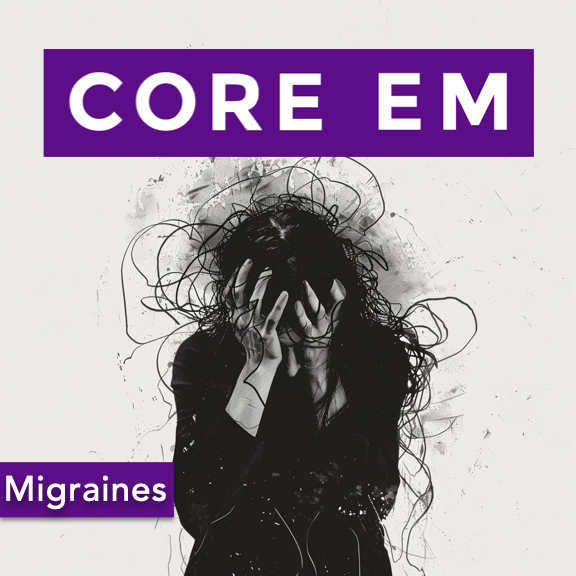Show Notes
Initial Approach to Diagnosing Migraines:
- Differentiating between primary headaches (migraine, tension-type, cluster) and secondary causes (e.g., subarachnoid hemorrhage).
- The importance of patient history and reevaluation after initial treatment.
- Recognizing the unique presentation of cluster headaches and their management implications.
Effective Acute Migraine Treatments:
- First-line treatments including anti-dopaminergic medications like metoclopramide (Reglan) and prochlorperazine (Compazine), and parenteral NSAIDs like ketorolac (Toradol).
- The limited role of triptans in the ED due to side effects and less efficacy compared to anti-dopaminergics.
- The use of nerve blocks (greater occipital nerve block and sphenopalatine ganglion block) as effective treatments without systemic side effects.
Treatments to Avoid or Use with Caution:
- Diphenhydramine (Benadryl): Studies show it does not prevent akathisia from anti-dopaminergics nor improve migraine outcomes.
- IV Fluids: Routine use is not supported unless the patient shows signs of dehydration.
- Magnesium: Conflicting evidence with some studies showing no benefit or even harm.
Managing Refractory Migraines:
- Second-line treatments including additional doses of metoclopramide combined with NSAIDs or dihydroergotamine (DHE).
- Considering opioids as a last resort when other treatments fail.
- The potential use of newer medications like lasmiditan and CGRP antagonists.
Preventing Recurrence of Migraines:
- Administering a single dose of dexamethasone (4 mg IV) to reduce the risk of headache recurrence after discharge.
- Prescribing NSAIDs or triptans upon discharge for outpatient management.
- Recognizing and addressing chronic migraine, and initiating preventive therapies like propranolol when appropriate.
Key Takeaways
- Differentiate Primary from Secondary Headaches and Reassess After Treatment:
- Use patient history and reevaluation post-treatment to distinguish migraines from more serious conditions, reducing unnecessary imaging and procedures.
- First-Line Treatments Are Effective:
- Anti-dopaminergic medications and NSAIDs are the mainstay of acute migraine treatment in the ED.
- Reserve opioids for cases unresponsive to multiple lines of treatment.
- Avoid Unnecessary Interventions:
- Diphenhydramine and routine IV fluids do not have proven benefits and can be excluded to streamline care.
- Utilize Nerve Blocks for Refractory Cases:
- Greater occipital nerve blocks and sphenopalatine ganglion blocks are effective alternatives for patients not responding to medication.
- Prevent Recurrence with Dexamethasone and Outpatient Planning:
- A single IV dose of dexamethasone can help prevent recurrence.
- Provide prescriptions and consider preventive therapies to reduce future ED visits.
